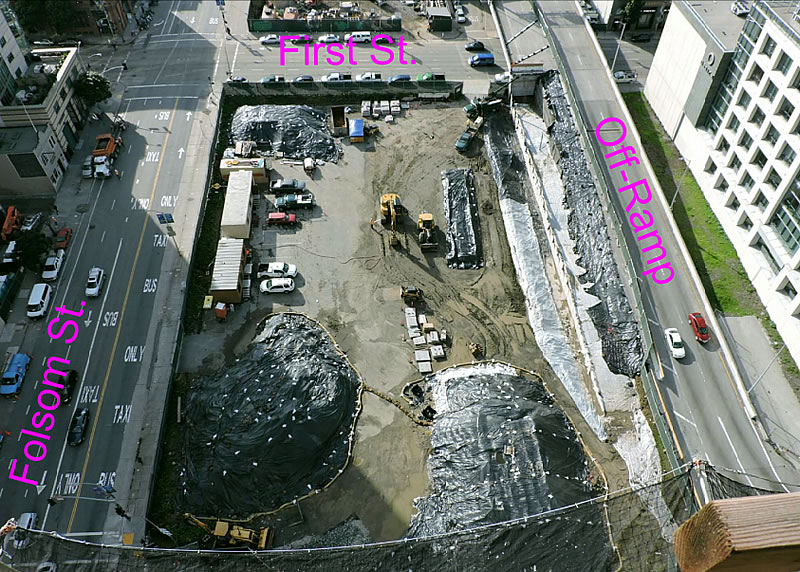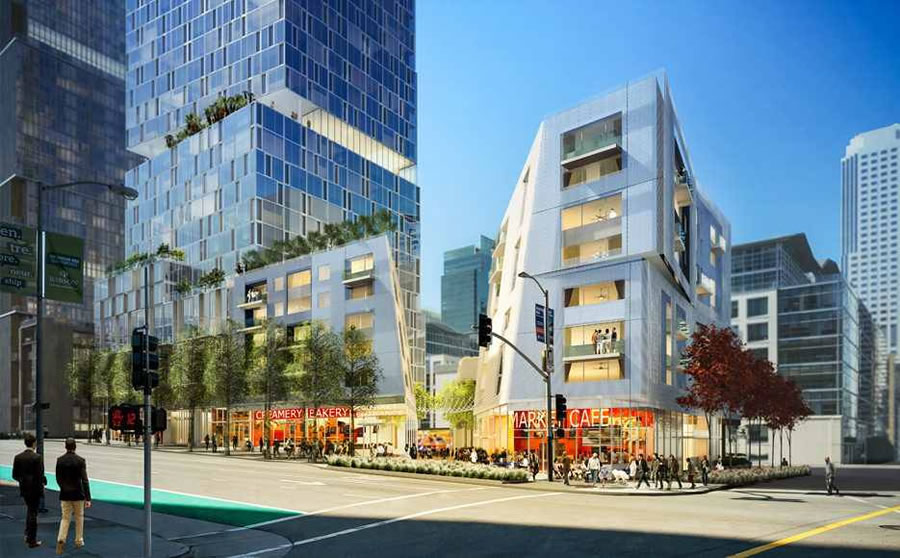Having already increased the budget for the realignment of the Folsom Street off-ramp from $2,883,900 to $3,479,541, the City is now slated to add another $1.2 million, for a total project cost of $4,679,541 and counting, 62 percent over the project’s original budget.
As we first reported last month, the cost overruns are primarily due to the discovery of higher than expected levels of motor oil and lead in the soil below, soil which has been stockpiled and covered on site, as pictured above, for testing and proper disposition.
The piles, however, have been preventing work on the off-ramp from proceeding as planned. And as such, the realignment, which was originally scheduled to be completed last month, isn’t expected to be finished until June at the earliest.
The realignment will clear the way for the 550-foot tower designed by Architect Rem Koolhaas and the Office for Metropolitan Architecture (OMA) to rise on the Transbay Block 8 site, with the potential for a Whole Foods on the corner.
UPDATE: The estimated completion date for the off-ramp realignment has been pushed back to the first week of July.


So dumb. So very, very dumb. Literal millions wasted to remove soils that at a site that’s going to be paved over and never tilled. And we wonder why we can’t build ‘jack’ in this country…
It’s not going to be “paved over,” it’s going to be excavated to build that tower. Buildings have basements!
What’s really outrageous is that Caltrans plans to spend $4.6M to rip out a temporary freeway ramp it just built not too long ago, the sole purpose of which was to make it easy for Bay Bridge drivers to exit from either side of the freeway, continue along their choice of two different, meandering elevated freeway off ramps, and end up at one of two exits, within a couple blocks away from each other (!).
This is incredibly insane. How many dozens of millions of dollars went into rebuilding the “two exits to the same place” design of the 1930’s Bay Bridge, which was originally designed to use those paths for on AND off ramps back when the top deck was two way traffic?
Caltrans doesn’t think, it just builds vast planes of concrete in the air. Look at the “new” Bay Bridge they devised: using obscure methods to construct a spectacularly expensive roadway that isn’t really remarkable in appearance but does not even match the old bridge in capacity, because there’s absolutely no provision or accounting for ever adding rail to the new design of the West side again.
And rather than using the ’89 earthquake as an opportunity to rethink and develop modern transportation along the Bridge and 80 freeway corridor, all Caltrans did was rebuild what was there, except for the part the City forced them not to rebuild, resulting in ramps that make zero sense.
The least sensible part is this multimillion dollar offramp lane built across an empty lot that was known to be developed soon, requiring nearly $5M (so far) just to rip it out a few years later. This lane serves little traffic and no real purpose.
And yet, when we try to build anything resembling real transportation projects, Caltrans and the general population freaks the f out because its “too expensive.” We can’t even have working escalators in the Bart system.
On the world stage, the Chinese and EU are making us Americans look like a bunch of supreme fools, as we’re building nothing but 1950s freeways while they’re constructing the modern marvels of intermodal links using modern metros, high speed rail and tunneled auto traffic. We have laws, meanwhile, that prevent underground freeways because drivers need a view (!).
But lets go back to hating “Tech,” because as soon as we can destroy our last growth industry, we can comfortably sit back and sell off our remaining housing in SF to billionaires from China, then move to someplace like the suburbia being built in the desert next to Vegas. And die miserable as we deserve to.
I think I agree with your entire rant (what is there to disagree with?).
It’s the best rant I’ve read on SS all year. Maybe all time.
…aaaaand, that basement will be swaddled in concrete walls and floor, n’est pas? We’re not talking a farmhouse root cellar here; bottom line, ain’t no one gonna be touchin’ that dirt, but we’re nevertheless going to spend millions to remove it.
It’s not the soil left onsite that’s the problem, it’s all the soil that has to be excavated and removed. Digging these enormous foundations generates tons of “waste” dirt that has to go somewhere. If it’s clean, it can be used as fill in any number of ways, but contaminated fill is much more difficult to get rid of. You don’t want it to be used on the next playground, park, or housing development. It takes a lot of time and money to sample it correctly so you are not mixing good fill with bad, and it costs a lot more to manage if you have to either clean it up or put it in a haz waste landfill,
(Which is not to imply that I don’t agree with your rant too, which I do!)
can we get married?
Correct me if I am wrong, but the city was able to sell the land for quite a bit of money.
My god sir–
That was beautiful.
Couldn’t agree more with nearly every point.
I would like to subscribe to your newsletter.
UPDATE: The estimated completion date for the off-ramp realignment has been pushed back to the first week of July.
If this $4.5M were being spent on bike infrastructure there would be people posting here claiming that this sum would be better spent on a subway. But not a peep here since this project benefits motorists. “Little” freeway projects like this gobble up sums that could fund significant expansion to the bike network and we just accept it as background noise to keep the status quo. There’s a double standard.
Portland calculated that the cost of building its 300+ mile bikeway network is the same as 1 mile of urban freeway. Fact is, many freeway (and bridge – see “Bay Bridge”) projects are extremely expensive to begin with, then hemorrhage more funds along the way with oversight from agencies like Caltrans. And very often, no one questions it. Bikeway projects have an amazing cost-benefit ratio – 12′ of bikeway can carry 12,000 people an hour, versus 2000 cars (or about 2500 people at today’s carpooling volumes). And bikeways need very little maintenance since they don’t carry heavy traffic.
actually bikeway projects are totally inefficient. while they may be designed “to carry 12,000 people an hour, versus 2000 cars” in actuality they carry <400/hr on the busiest bike lanes, and less than 20/hr on some of the bike lanes, while at the same time taking away car lanes that could carry 10x the people in said lane
By that way of measuring most new highway and freeway link projects are inefficient too because they start out with a small amount of traffic and build up to capacity. Keep in mind that the bike network is still very fragmented and far from complete. Until a novice rider can complete all of their weekly travel without dealing with white knuckle road situations, the number of bicyclists will remain far lower than the potential.
Compare that to the road network which had complete connectivity long before anyone of use were born. And then it was beefed up, breaking bicycle connectivity even worse with large freeways either removing connections or placing high speed interchanges right in the middle of formally accessible connections.
if thats true then why has the ridership in portland not increased since they added all their new lanes?
Is the Portland network complete? Last I heard there were still numerous significant gaps.
@Milkshake..what is “complete”? When are we allowed to start surveying whether the bikes lanes are a success?
“technically, Portland reached that wall in 2008, when the number of commuters riding downtown plateaued at just over 6% — but the city kept spending anyway.
Despite new and better cycle lanes, the number of work-day peddlers remained stagnant after ’08, even dipping slightly, while the number of cars stayed the same.
Stagnation, in the face of a landmark 2010 decision to invest $613 million into bicycle commuting, in hopes of increasing that ratio to 25% by 2030.
Six years later, the number of cyclists remains the same, and Portland is finally saying enough.”
(Calgary Sun newspaper…March 14, 2014)
I don’t think that there’s consensus on exactly what “complete” is. My guess is that it fits into a formula like “P% of residents are able to complete J% of their monthly journeys”. I’d conservatively put P at 20% just because that’s about what other cities in the developed world have accomplished. J needs to be well above 50%.
As for success you don’t need a complete network to see that bike lanes invite people to switch over. Exhibit A: Valencia St.
Yes, bike lanes get approved without having to prove that they improve transportation. In fact, some bike lanes are approved even when the best studies show they will retard movement of people. For better or worse, depending on pov, the bike network is not being developed by the same standards as apply to transit and auto.
Since there aren’t anything like 12k bikes/hour trying to ride around any street in SF, they are all vastly underutilized. I’d be surprised if during the peak commute hour there were that many bikes on all the streets of SF taken together.
I don’t know about Portland’s accounting, but in SF the budgets for bike lanes do not account for the value of the land being taken for the bikes. It is not like the bike network budget buys these existing roadways, which are very valuable assets. It just gets them for free, per the accounting.
This ramp carried 25-30k cars/day. I guess it could have been shortened to dump them off on Essex. That would have saved some money and opened some land for development, but then you would have all those extra cars just clogging Folsom and other streets on the way to downtown.
And of course there were plenty of “peeps” about removing the elevated roads to/from the bridge. SF did get most of them torn down over the objections of Caltrans and many businesses. Used to go all the way to Broadway.